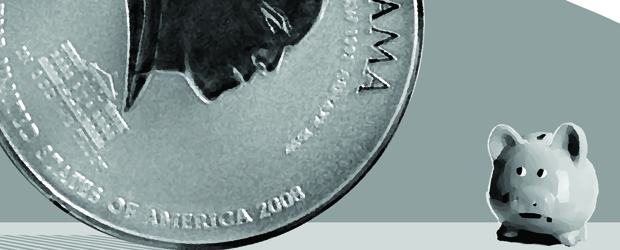I was at a friend’s house over Winter Break when I first heard mention of the “Trillion Dollar Coin” idea. Naturally, my first reaction was to laugh out loud. But as my laughter died down, my friend told me, “No, it’s actually serious.”
Really? Is this what our deficit problems have come to? The minting of a trillion dollar coin? I just want to reiterate this, in case you didn’t get it. We’re talking about a trillion dollar coin. To put that in perspective, it’s fifteen times the net worth of Bill Gates. It’s enough money to purchase the entire annual production of Madagascar a hundred times over. And this ridiculous sum of money would be minted as a single coin.
Such an idea begs certain questions. We generally think of money as a practical way of exchanging value, but just how practical is a trillion dollar piece of metal? Imagine walking into a department store, picking up a $7 dollar bottle of shampoo, and saying, “Hey, can you break a trillion?” “Sure,” says the cashier. “Would you like that in store branches or a $999,999,999,993 loan which we’ll pay off over the next few decades?”
Lack of practicality aside, what if the trillion dollar coin gets lost? Or, worse yet, stolen? I hardly think conventional police work would be effective when the thief buys a private army and a small nuclear arsenal.
Am I being facetious? I apologize. The trillion dollar coin is actually a very serious, legitimate economic idea, endorsed by various economists, including Nobel Prize winner Paul Krugman. I am not an economist, but I’ll try to explain the basic concept. The United States has something called a debt ceiling, which is basically a limit on the amount of national debt that can be issued by the treasury. This means that if the treasury is unable to pay its obligations, we must either scramble to raise the ceiling or default on some of our loans. Defaulting would mean serious repercussions, including but not limited to financial crisis, recession and a profound sense of national shame.
With the recent debates over the fiscal cliff, the debt ceiling has been a hotly-debated topic. How do we avoid defaulting on our loans while maintaining our current level of spending? If we cut spending, we would have to say goodbye to all sorts of government programs. If we raise the debt ceiling, we will just go further into debt. If we do nothing, we default and plunge into another recession. So what’s the solution?
Well, isn’t it obvious? Mint a trillion dollar coin! According to a useful loophole in our legal system, the Treasury has the authority to mint “collectible” platinum coins at whatever value it sees fit. All we have to do is create a few trillion dollars, deposit it in the Federal Reserve, and voilà! Financial problems solved. Who would have known it would be so simple? And all this talk of debt ceilings and loan defaults was giving us such a headache!
Any potential problems? Well, there is the issue that we would be creating massive amounts of money out of thin air. Of course, that is essentially what many nations have been doing since they went off the gold standard during World War I. Paul Krugman has criticized opponents of the trillion dollar coin by pointing out their failure to recognize that “money is a social contrivance.” Even gold is only valuable because we say it is. And yet, the fact that there is a finite amount of gold in the world makes it a little more stable than something like, say, paper. Germany’s hyperinflation in the 1920s, where people pushed wheelbarrows of notes to the market to buy loaves of bread, is an ominous reminder of what can happen if we simply print unchecked quantities of money.
In light of history, the trillion dollar coin idea seems, quite frankly, terrifying. We would be willfully devaluing our currency by massive amounts, all at once. I’ve heard some people ask if the coin would actually contain a trillion dollars’ worth of platinum. At platinum’s current value, that would mean an 18,621-ton “coin.” That’s the weight of forty-two Boeing 747s. I’m doubtful it could fit in the Federal Reserve, but at least we could melt it down and sell platinum fillings if we were ever in dire straits.
This coin would have value simply because we would say that it does. As Andrew Greaves ’13 pointed out, “Why even use platinum? If we’re just creating money anyway, we might as well create a trillion dollar rubber ducky.”
Honestly, I’m quite relieved that the idea of the trillion dollar coin was rejected. The idea that we can solve our economic woes by creating huge quantities of money out of nowhere does not strike me as a sound economic strategy.
Economist Joe Firestone claims that “the trillion-dollar coin could solve the government’s debt problems once and for all, putting within its grasp the power to replace austerity with the abundance enjoyed by our forefathers.” (Huffington Post).
Well, I’m not an economist, but that sounds a little overly optimistic to me. I suggest we start by re-assessing our huge levels of government spending, particularly our spending on the military. Perhaps we should think about how going to war and cutting taxes at the same time was not such a bright idea. Money may be a social contrivance, but it stands for something real, and we’re not going to solve our real problems with a trillion dollar sleight of hand.









